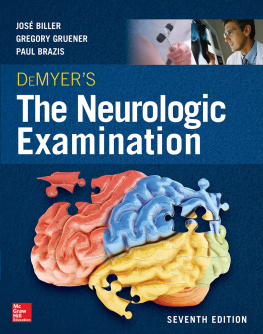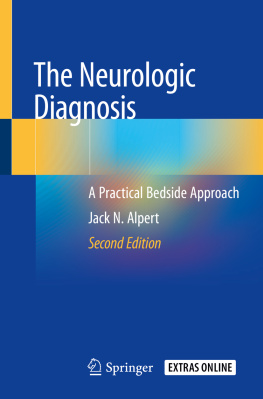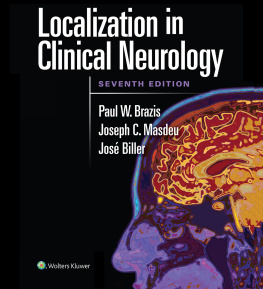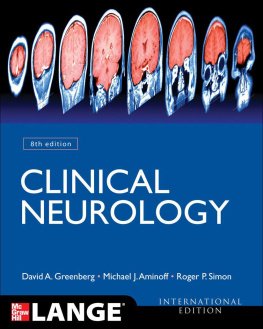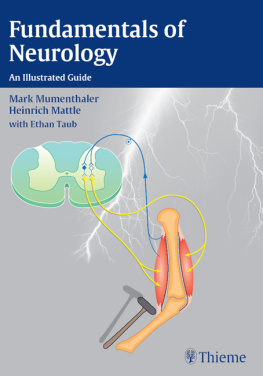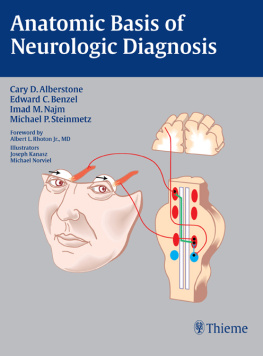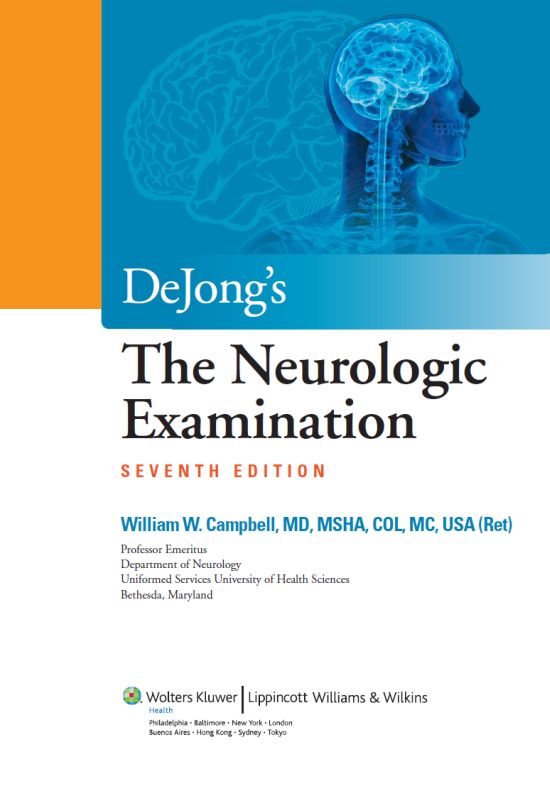DeJongs
The Neurologic Examination
SEVENTH EDITION
Acquisitions Editor: Julie Goolsby
Product Manager: Tom Gibbons
Vendor Manager: Marian Bellus
Senior Manufacturing Manager: Benjamin Rivera
Marketing Manager: Alexander Burns
Design Coordinator: Steven Druding
Production Service: SPi Global
2013 by LIPPINCOTT WILLIAMS & WILKINS, a WOLTERS KLUWER business
Two Commerce Square
2001 Market Street
Philadelphia, PA 19103 USA
LWW.com
(2) 2005 by Lippincott Williams & Wilkins. 1992 by JB Lippincott Co. All rights reserved. This book is protected by copyright. No part of this book may be reproduced in any form by any means, including photocopying, or utilized by any information storage and retrieval system without written permission from the copyright owner, except for brief quotations embodied in critical articles and reviews. Materials appearing in this book prepared by individuals as part of their official duties as U.S. government employees are not covered by the above-mentioned copyright.
Printed in China
Library of Congress Cataloging-in-Publication Data
Campbell, William W. (William Wesley)
DeJongs the neurologic examination. 7th ed. / William W. Campbell.
p. ; cm.
Neurologic examination
Includes bibliographical references and index.
ISBN 978-1-4511-0920-7 ISBN 1-4511-0920-2
I. DeJong, Russell N. Neurologic examination. II. Title. III. Title: Neurologic examination.
[DNLM: 1. Neurologic Examination. WL 141]
616.8'0475dc23
2012008540
Care has been taken to confirm the accuracy of the information presented and to describe generally accepted practices. However, the authors, editors, and publisher are not responsible for errors or omissions or for any consequences from application of the information in this book and make no warranty, expressed or implied, with respect to the currency, completeness, or accuracy of the contents of the publication. Application of the information in a particular situation remains the professional responsibility of the practitioner.
The authors, editors, and publisher have exerted every effort to ensure that drug selection and dosage set forth in this text are in accordance with current recommendations and practice at the time of publication. However, in view of ongoing research, changes in government regulations, and the constant flow of information relating to drug therapy and drug reactions, the reader is urged to check the package insert for each drug for any change in indications and dosage and for added warnings and precautions. This is particularly important when the recommended agent is a new or infrequently employed drug.
Some drugs and medical devices presented in the publication have Food and Drug Administration (FDA) clearance for limited use in restricted research settings. It is the responsibility of the health care provider to ascertain the FDA status of each drug or device planned for use in their clinical practice.
To purchase additional copies of this book, call our customer service department at (800) 638-3030 or fax orders to (301) 223-2320. International customers should call (301) 223-2300.
Visit Lippincott Williams & Wilkins on the Internet: at LWW.com. Lippincott Williams & Wilkins customer service representatives are available from 8:30 am to 6 pm, EST.
10 9 8 7 6 5 4 3 2 1
Dedicated to
Wes, Matt, Shannon, Will, and Ella
PREFACE
The continuing relevance of the neurologic examination was defended in the preface to the sixth edition of this book, published in 2005. In 2009, Professor Christopher Hawkes wrote an editorial in Practical Neurology entitled Ive stopped examining patients! (1). In it, he observed that he increasingly found himself examining patients with their clothes on or while they were sitting in the chair, or even more alarmingly, not examining them at all. He found this by tracking when he did or did not examine patients, and found that he did little or no examination in 44% of his new patients. He often skipped the examination in patients with such conditions as sleep disorders, seizure, syncope, TIA, dementia, and dizziness. Obviously the history is paramount in the diagnosis of such conditions, and the examination plays a lesser role.
In a subsequent editorial, Why I have not stopped examining patients by Practical Neurologys editor, Professor Charles Warlow, we learned that Professor Hawkess editorial prompted more letters than almost all previous articles combined (2). The editorial, and many of the following letters, argued for the continued germaneness of the examination, and reasons to do it other than for strictly diagnostic purposes. Professor Warlow listed such things as time to think, time to look (peering closely at the patient while his eyes are closed while examining for drift), avoiding unnecessary, expensive, and sometimes risky investigations, getting a feel for normal, and impressing and reassuring the patient. He observed that patients come to hospital to be examined, not to be interrogated; it is difficult to compete with British eloquence.
A letter from a senior medical student and future neurologist expressed bewilderment at Hawkess editorial. She asked how the next generation of neurologists will ever acquire the necessary skills to practice the art of neurology if their mentors stop examining patients.
Obviously the history is paramount and the examination of little use in the diagnosis and management of certain disorders, as Professor Hawkes pointed out. But there are conditions in which the examination plays a key role. Examples include myasthenia gravis, jugular foramen syndrome, amyotrophic lateral sclerosis (ALS), Parkinsons disease, progressive supranuclear palsy (PSP), cortical basal degeneration, inclusion body myopathy, brachial plexopathy, Huntingtons disease, Charcot-Marie-Tooth disease, the phakomotoses, and in the evaluation of coma and brain death, to name just a few. Although we rely heavily on imaging studies, they are of very little use in the diagnosis and management of these conditions.
There are many situations in which the examination is essential. It is the examination that drives the initial evaluation of the patient with rapidly evolving generalized weakness. Is it Guillain-Barr, or transverse myelopathy? Is it better to order an electromyogram (EMG) or image the spine, and if so, at what level? Finding abnormal pupils prompts consideration of botulism; finding muscle tenderness and edema prompts consideration of rhabdomyolysis.
The diagnosis depends on examination findings in such common conditions as positional vertigo and Bells palsy. How would you recognize that the overweight female before you has intracranial hypertension instead of tension-type headaches if you cannot recognize papilledema, and have the confidence in making the call that comes from having done many funduscopic examinations? When the possibility of cauda equina syndrome arises, the physician who cannot properly examine strength, sensation, and reflexes in the lower extremities, and assess sphincter function, is in trouble. The rejoinder, of course, is if the possibility of cauda equina syndrome arises, just order an imaging study. However, routine imaging will not detect the pathology in such conditions as Lyme disease, cytomegalovirus (CMV) infection, neoplastic infiltration, sarcoidosis, or spinal cord arteriovenous malformation (AVM). It is largely the examination findings that drive imaging to a higher level or prompt a cerebrospinal fluid (CSF) examination. The ability to practice magnetic resonance imaging (MRI)-negative neurology is essential.
Next page

